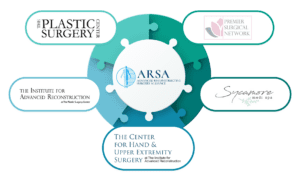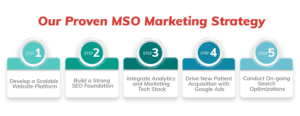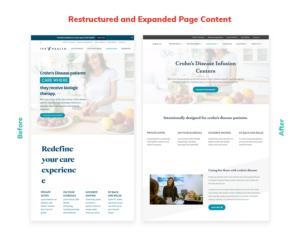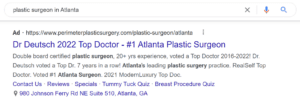A management services organization (MSO) needs a solid infrastructure to thrive in the competitive healthcare industry. Typically, physician owners and private equity (PE) firms are focused on finding operational efficiencies, capitalizing on economies of scale, eliminating administrative redundancies, and leveraging new technologies as means to generate value. One aspect that is frequently overlooked is the marketing strategy.
To maximize value creation, it’s crucial to have a scalable digital marketing strategy that is easy to launch and scale with new acquisitions. For a new MSO, the ultimate goal is to drive new patient volume quickly, which means you don’t want to spend time developing new sites and campaigns for every new acquisition.
Throughout our years of experience in the healthcare industry, we’ve developed a proven marketing framework that helps MSOs grow efficiently and effectively. We’ve helped countless clients like IVX Health, ARSA, SENTA, and Water’s Edge Dermatology build dependable patient pipelines that can scale with them.

In this article, we’ll explore Cardinal’s proven marketing framework for MSOs, which includes:
- Develop a Scalable Website Platform
- Build a Strong SEO Foundation
- Integrate Analytics and Marketing Tech Stack
- Drive New Patient Acquisition with Google Ads
- Conduct On-going Search Optimizations
This approach will allow you to focus on securing the next deal instead of worrying about developing a new digital marketing strategy from the ground up for every new addition.

1. Develop a Scalable Website Platform
Your website is the foundation of your MSOs’ digital presence, which is why it is one of the most important steps when you build your post-acquisition marketing strategy. As an MSO, your goal is to develop a website that can easily integrate new acquisitions and support your patient acquisition goals. To do this, one of the first decisions you will make is if you want to form a branded house or a house of brands.
The former involves absorbing all new brands under one name, allowing you to create one website, one tech stack, one unified brand message, and one core advertising strategy. A house of brands, on the other hand, allows individual brands to maintain their identities while still being a part of your organization. While this individuality has its benefits, it also requires more time and energy to support each individual brand. As a result, it may be difficult to achieve maximum efficiency.
Many MSOs settle on a compromise and build a hybrid brand structure, where there is an umbrella brand, and some practice groups retain their identity. For a house of brands and a hybrid brand structure to be successful, the key is to build a modular website platform.
Too many website development agencies will develop clunky content management systems (CMS) or they’ll stand up disparate WordPress sites. This makes scaling difficult and costly.
We develop our websites on WordPress with a modular framework. The essential page structure, information hierarchy, and functionality are the same across websites, but we can build some customization on the individual brand level so they can appeal to niche market segments. As a result, a unified visual identity and experience run through each brand’s website in the platform.
In other words, the structure of every website will be the same, but you can change the visual graphic elements to differentiate each brand. This approach allows your brands to maintain their identity and brand equity and helps you avoid building new websites from the ground up with every acquisition.
2. Build a Strong SEO Foundation
When building your platform’s website, search engine optimization (SEO) needs to be part of the conversation. Too often, healthcare groups and web design agencies will develop a beautiful site that can’t rank on Google.
Your website will house all the vital information you want potential patients to know, but leading patients to it is a more significant part of the battle. That’s where building a strong SEO foundation comes into play. These days, search engines—namely Google—is the primary place people turn to for information, including health-related topics.
For new MSOs, we recommend a two-part approach that will help them gain organic visibility as quickly as possible.
Develop a Solid Technical SEO Foundation for Your Website
A robust technical SEO foundation is crucial for new MSOs. If your website fails to adhere to SEO best practices, it will struggle to gain visibility in local markets.
This process also involves building an organized site architecture, optimizing site speed, implementing structured data, adding XML sitemaps, removing duplicate content, using language tags, utilizing internal links, and setting up 404 pages and any other redirects. Ultimately, your goal is to make your site clean and organized on the backend so it appears that way to potential patients on the front end.
Read our article “7 Essential Principles for Optimizing Your Website for Search” to get our best practices for building a search-optimized website.
We can’t stress this enough: don’t build a new website for your platform without a strong SEO foundation. You’ll struggle to rank for high-intent organic searches and build a dependable patient pipeline.
Create a Robust SEO Content Strategy
An empty website with no information won’t rank. You must develop content that answers your target patients’ questions at each stage of the patient journey. Too little content on a page can make it difficult for Google to understand your website, hindering your ranking potential for relevant queries.
After you build your technical foundation, you should prioritize creating robust SEO content that can be used for all brands within your platform. This means creating original content that is simple, straightforward, and easy for your target audience to digest while also optimizing it with target keywords, links, meta tags, and more.
Prioritize your service and treatment pages first, as these pages will help you rank for middle-of-the-funnel (MOF) and bottom-of-the-funnel (BOF) search queries. This will allow you to generate organic growth as quickly as possible.

Service/Treatment Page Best Practices:
- Structure the site so pages live directly off the main navigation, and they should be no more than two to three clicks deep into the site.
- Use only one H1 heading per page. From there, headings should be in a descending hierarchy.
- Expand the content so that each page is 800-1200 words.
- Ensure pages are unique across brands to avoid duplicate content penalties.
- Use sub headers should break content up into bite-sized content for readers, such as an overview of the service, who it helps, what conditions are associated with this treatment/service, steps to booking an appointment, insurance, FAQs, etc.
We’ve also seen that core condition pages are beneficial to further expand visibility on Google. These pages convey a general understanding to both search engines and users that you do have treatments for their concerns.
3. Integrate Analytics and Marketing Tech Stack
A centralized marketing tech stack is the next core element of your MSO’s marketing foundation. This is the real bread and butter of marketing operational efficiency. Not only will a centralized tech stack allow you to eliminate redundant systems and reduce marketing costs, but it’ll also be easier to onboard new acquisitions. This is because you’ll have an established marketing tech stack and processes to integrate new brands quickly.
Your tech stack will include things like:
- Customer Record Management System (CRM): Salesforce is the gold standard for CRMs. It’s HIPAA compliant and integrates easily with different reporting tools, ad platforms, and marketing automation systems. Far too few healthcare groups have CRMs. If you’re building a platform from the ground up, now is your chance to gain more visibility into your patient acquisition pipeline.
- Tracking and Analytics: We utilize integrations with Salesforce and Ruler to centralize and optimize data analytics for marketing campaigns.
- Call Tracking: Our preferred vendor is CallRail, which allows you to track calls and conversions by focusing on technical integrations, data accessibility, and ease of pixel implementation.
- Reputation and List Management: Both Yext and Podium programs are helpful in this regard as they begin listing cleanup and review gen programs for you.
In the podcast “Scaling MSOs Post-Acquisition: How to Build A Repeatable Marketing Strategy,” Cardinal’s SVP of Healthcare Marketing, Lauren Leone, has the following advice for integrating technologies:
“What you don’t want to do is have an inconsistent experience and an inconsistent tracking mechanism, so that you don’t know if Dr. Stevens’ practice is performing this way because of competitive pressure or they just have a poor user experience, or they have operational issues. Let’s create one uniform system to track and monitor performance across brands.”
By building an integrated marketing technology ecosystem with the right tools and technologies for your platform, you’ll be able to assess performance and understand what is and isn’t working. Then, you can pivot your marketing strategy as needed. Without an integrated technology stack, gaining insight into performance across your platform will be difficult.
For more tips on streamlining your marketing operations, our article, 5 Best Practices for Centralizing Marketing Post-Merger, examines the core marketing activities you should focus on when building a consolidated platform.
4. Drive New Patient Acquisition with Google Ads
We don’t recommend launching media campaigns until you have a strong patient booking experience developed. You need that basic infrastructure to accept phone calls and process form or online booking requests. If you don’t have time for a full website build that integrates these booking options, we recommend at least standing up a landing page. This can be done in two to three weeks and allows you to book new patients while you build the rest of your infrastructure and website.
Once you’ve built the core components of your MSO’s digital platform, it’s time to capture existing demand and fill your appointments.
For a new MSO, your primary focus should be on paid search Google Ads since so many people turn to search engines to find medical information and providers.
To build the most efficient and scalable strategy, you should focus on capturing relevant volume at the bottom or lower mid-funnel keywords. These campaigns target search intent around brand keywords or more transactional non-brand terms such as ‘orthodontist near me’ or “plastic surgeon in Atlanta” that show purchase intent.

Remarketing efforts can and should be deployed to re-engage warm leads as they shop around in the middle of the funnel.
After you fully optimize your BOF campaigns, then you can layer on demand generation campaigns. TOF demand generation campaign can help you improve brand awareness and equity in new markets and educate consumers on your services.
5. Conduct On-going Search Optimizations
SEO isn’t something you can simply set up and forget. The healthcare search landscape is competitive, and there’s always someone working against you to secure the top position on Google. To ensure that you maintain existing rankings or breakthrough ranking plateaus, we advise you to invest in the following SEO tactics:
Ongoing Technical Audits
After your site launches, don’t think your job is over. You’ll need to conduct ongoing audits and optimizations as you roll in new brands. Complacency and poor processes can allow technical issues to creep into your site. Make routine audits part of your team’s onboarding process to ensure that new acquisitions are properly integrated.
You’ll also want to ensure that there’s no traffic loss when you migrate brands from one domain to the new MSO platform’s domain. Our Director of SEO Strategy, John McAlpin, advises:
“Before you migrate a site, you should take an extensive crawl of the original site. One of the biggest issues is people only look at what’s in the main navigation. There’s always hidden content on the web app, like patient forms, images, and old blogs that you should look for.”
Listen to our podcast “SEO Best Practices for Merging Websites” to get more tips for developing website migration plans for MSOs.
Link Earning
Backlinks provide Google with powerful ranking signals that indicate a sense of EAT (Expertise, Authority, Trust). A good backlink profile consists of a healthy mix of high-quality links with a large quantity.
New MSOs with new website domains frequently have little to no backlinks. When competing against similar brands in local markets, the number of backlinks can impact who ranks in the top position.
We recommend that you implement a systematic link-building strategy. These aren’t spammy black hat links. Instead, you should focus on creating link-worthy content and earning backlinks to that content through outreach initiatives. Earned links should be relevant to the linked content so that Google understands your niche.
Moving Forward: Launching Your Post-Acquisition Marketing Strategy
At Cardinal Digital Marketing, our mission is to provide comprehensive care for our clients within the healthcare industry, so they can better reach their target audiences and grow their businesses over time. We measure our success through the success of our partners, which is why we’ve created and implemented this proven playbook for bringing MSOs online quickly.
For your business, that means you can begin booking patients as quickly as possible as you add new acquisitions and locations to your MSO. You’ll be able to generate value right out of the gates. If you’re ready to learn more, get in touch with our team to learn more about our healthcare performance marketing strategies and how a partnership with our team can help grow your MSO.

